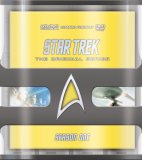| Reviews & Columns |
|
Reviews DVD TV on DVD Blu-ray 4K UHD International DVDs In Theaters Reviews by Studio Video Games Features Collector Series DVDs Easter Egg Database Interviews DVD Talk Radio Feature Articles Columns Anime Talk DVD Savant Horror DVDs The M.O.D. Squad Art House HD Talk Silent DVD
|
DVD Talk Forum |
|
|
| Resources |
|
DVD Price Search Customer Service #'s RCE Info Links |
|
Columns
|
|
|
Star Trek The Original Series - The Complete First Season (HD DVD)
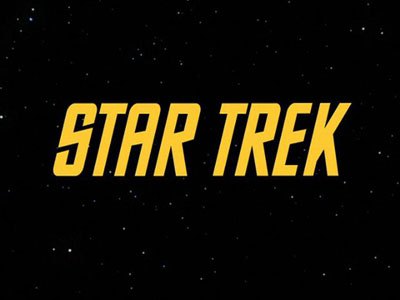
INTRODUCTION:
I still remember my first VCR, a clunky hulk of JVC technology that proved to be an eyesore in an otherwise attractive living room. Not many people had one at the time, and its cost was well beyond reasonable, but I could not avoid the temptation; for every weekday at midnight, local UHF broadcast station WGNX was branding itself "Starbase 46" and airing syndicated episodes of the original Star Trek. Finally, I could own my favorite episodes, and if it meant standing behind the television with an antenna hoisted above my head for an hour because the signal was too weak, then so be it -- it was Star Trek. My, how the times have changed. Restored from the original negatives, remastered for high-definition presentation, and digitally enhanced by a team led by Trek experts David Rossi, Michael Okuda, and Denise Okuda, these classic episodes appear for the first time on HD DVD, and the results are very impressive.
CONTENT:
Star Trek is so entrenched in the cultural zeitgeist that it is difficult to find anything new to say about it. Over 40 years after "The Man Trap" first aired on NBC, through 5 spin-off series and 10 feature films, the franchise lives on with yet another picture in the works for release late next year. Trek has been around so long that it spans generations of fandom, from those who were there in the early swashbuckling days of James T. Kirk (William Shatner) to viewers who grew up on the more diplomatic Picard (Patrick Stewart) to fans of the darker, more epic themes of Deep Space Nine. But at the core of this incredible legacy is Gene Roddenberry's original optimistic vision for the future, further developed by a talented group of writers and producers, and presented at its best in the opening season of the groundbreaking series.
After Star Trek's first attempt ("The Cage" starring Jeffrey Hunter as Captain Christopher Pike) was deemed "too cerebral" by network suits, the series received an unprecedented order for a second pilot episode, "Where No Man Has Gone Before". This new pilot shook things up quite a bit, re-casting everyone except Spock (Leonard Nimoy) and adding even more diversity to a show that was preparing to knock down the walls of what was conventionally shown on television. "Where No Man Has Gone Before" is wonderful storytelling, every bit as cerebral as the original pilot with a good old fashioned fistfight to top it off, and it sets much of the foundation for what would come to pass over the course of three seasons. Annoyingly, the network didn't believe this strong piece of television would grab the attention of audiences, so they aired an inferior episode titled "The Man Trap" first. Really the only thing "The Man Trap" has going for it over "Where No Man Has Gone Before" is that the former features a more colorful set, intended to take advantage of the relatively new color television market, but outside of that, I've always felt that the second pilot is a much better introduction to the characters and the series and is, quite simply, a more compelling hour of entertainment. Fortunately, both are on the same first disc in this release, so you can watch them in whichever order you like.
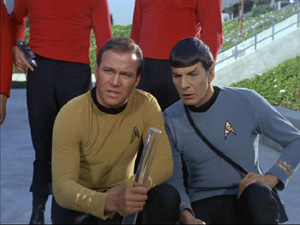
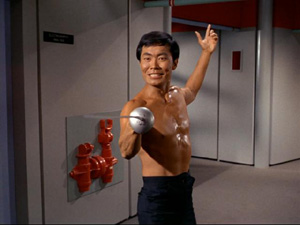
"Where No Man Has Gone Before" is the first of many episodes to address the nature of an individual achieving great power over his contemporaries. When cosmic circumstances lead Lt. Commander Gary Mitchell (Gary Lockwood) on the path to apparent Godhood, he becomes consumed with his new powers and annoyed at those he now perceives to be beneath him. Trek would return to this theme again, either in the form of petulant individuals with incredible powers like "Charlie X" and Trelane (William Campbell) in "The Squire of Gothos" or the genetically engineered superhuman Khan (Ricardo Montalbán) in one of the most famous episodes of the show's entire run, "Space Seed". "Space Seed" represents that perfect blend of action-adventure storytelling with a strong social message at its core. Khan is a fantastic adversary for Kirk, charming and intelligent and resourceful, but like many who possess great abilities, his arrogance is his undoing.
Season One features another of Kirk's great adversaries, the Romulan commander (Mark Lenard) in "Balance of Terror". Inspired by World War II submarine battles, "Balance of Terror" is a beautiful cat-and-mouse game between Captain Kirk and his Romulan counterpart aboard a cloaked Bird of Prey. Much like "The Corbomite Maneuver" before it, this classic episode is less about action-adventure and more about two intelligent foes trying to strategically out-think one another in a battle of wits. Paul Schneider would only write two episodes for the series, but they would be two of its best. "Balance of Terror" is most known for being the first introduction to the Romulans, but it is important to note the way this episode starts poking around to see what they can get away with in terms of racial commentary.
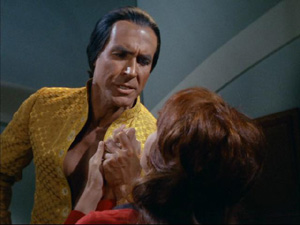
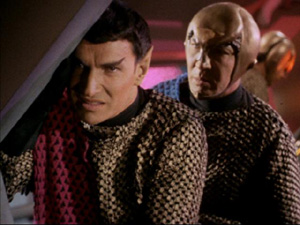
When you think about Star Trek, you must always consider the social and political climate of the mid-to-late 1960s. Networks did not want their television shows stirring up trouble, and few issues were more heated at the time than the civil rights movement and the war in the Vietnam. To fully appreciate the uphill battle Roddenberry faced, the original pilot episode featured a strong and confident female first officer (Majel Barrett) in a leading role, and female test audiences reacted negatively to the character. They weren't ready to see a strong woman in a leadership capacity -- can you believe she even wore pants?! -- so the series had to be more subtle, more subversive. One of the great benefits of science fiction, however, is that you can teach the audience something important about society without them catching on until it's too late, and Star Trek utilized that ability to perfection. In "Balance of Terror", Spock faces prejudice simply because he shares some similar physical features with the Romulan commander, and it opens the door to relevant social debate without overtly addressing contemporary issues.
The Romulans are interesting opponents for the Federation, but they're no Klingons, and this first season brings the war-faring empire to life as well in "Errand of Mercy". Written by Gene L. Coon, who also wrote "Space Seed" and was one of the behind-the-scenes architects of many foundation elements to the franchise, "Errand of Mercy" poses many questions about the nature of war. Kirk and crew are convinced they are the "good guys", their war with the Klingons clearly a just one, but the Organians have their own desires and want no part of the escalating hostilities.
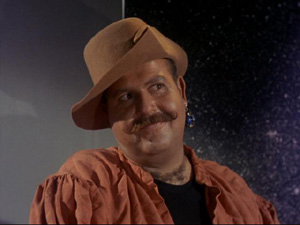
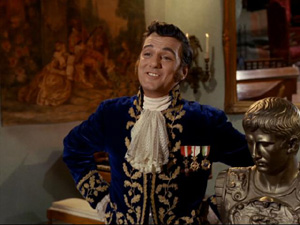
Many other great episodes are showcased in this first season, presenting a good balance of humor, action, and science fiction. "The Naked Time" addresses what lies beneath our professional inhibitions, and "Mudd's Women" covers the nature of inner beauty and personal confidence. Both are very funny episodes, with the former reused in future series and the latter inspiring a sequel for the second season. More serious science fiction topics are tackled in "What are Little Girls Made Of?", Star Trek's first journey into the world of artificial intelligence, and "Dagger of the Mind", a solid story that addresses the nature of individuality and the use of mind control as a method of "rehabilitation". But Star Trek's first season is probably best remembered for Harlan Ellison's standout episode, "The City on the Edge of Forever". Brilliantly constructed, it is rightfully considered by most to be the best episode of the original series and one of the finest in the entire franchise. It perfectly captures the essence of Trek, blending comedy with drama in beautiful poetry, and leading our heroic characters to make great personal sacrifice in pursuit of doing the right thing. When Kirk steps out of the Guardian and says, "Let's get the hell out of here", it gets me every single time.
It is difficult to overstate just how important Star Trek was to the television landscape and the culture at large. Just seeing a black woman on the bridge in a role of great responsibility on a weekly basis had profound impact on a generation of viewers, but Star Trek aimed higher than that with subversive social commentary hidden within classic elements of great science fiction. This first season showcases some of those best efforts, ever anchored by the wonderful dynamic between Kirk, Spock, and McCoy (DeForest Kelley), with only a handful of duds in the entire mix. Having seen these episodes so many times over the years, I was surprised just how much I enjoyed watching them all again for this review. The social relevance doesn't carry the same impact it did back in 1966, but the first season of Star Trek remains immensely entertaining.
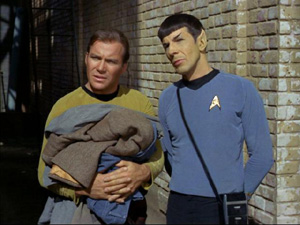
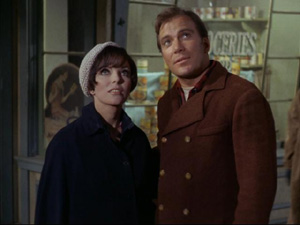
PRESENTATION:
PACKAGING:
Star Trek arrives on HD DVD with the first season spread across 10 combo-discs, with HD DVD content on the A side and SD DVD on the B. These discs latch into 10 thin, near-square, plastic cases that are held together in booklet form by clear tape at the spine. The total footprint of this booklet is near identical to the previous DVD release of the Star Trek series. This plastic booklet slides into the top of a gold cardboard container with a slot in the back to house 5 cards that describe what is on each of the discs. These cards are labeled "Special Collector Data Cards" in the promotional material, but that's an overly grandiose sell for what amounts to a nice-looking obligatory descriptive insert, necessary since the double-sided discs are without labels. The cardboard housing fits into a larger clear-plastic enclosure that is hinged at the bottom in such a way that the gold housing appears suspended in the air within the outer enclosure. The total package looks okay, but it seems a little too stylish for its own good. I know I'm in the minority, but I prefer the tricorder look of the previous release.
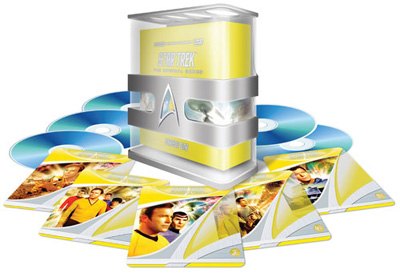
No matter what you think of the appearance, the real downside to this packaging is that it is incredibly prone to damage. Looking at the way mine arrived at my door, I don't see how this set could survive shipping without significant damage. On my copy, the outer Trek insignia was heavily scuffed, the cardboard casing was torn or visibly dented at all 12 contact points for the enclosure, and chunks of plastic rattled about the inside from the busted plastic casings. When you ask customers to spend this much money on home media, one would expect a lot more care than this.
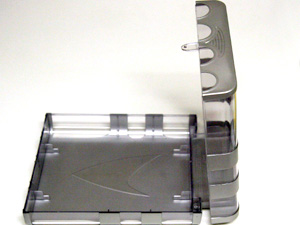
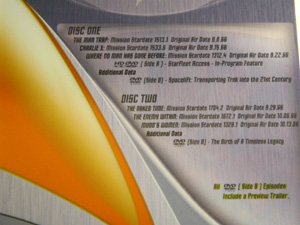
N.B.: Likely due to the discs breaking free of their enclosure during shipment, there are flaws in my discs that cause my Toshiba HD-A2 to crash when trying to play "The Naked Time" or the final chapter of "The Menagerie, Part II". Paramount is graciously shipping me replacement discs to confirm that it is an isolated problem, but it should be noted again that the packaging on this set is prone to heavy damage, and I highly recommend purchasing it from a reputable dealer with a good return policy. If it can happen to me, it can happen to you.
Update (11.20.07): The replacement discs have arrived, and I am disappointed to report that the packaging is in even worse condition than the first attempt (if you can believe that). The hinge on the outer enclosure is completely busted, so it won't stand upright without falling apart, and the gold cardboard sleeve is punctured all the way through. The plastic disc cases are once again broken, with shards of plastic rattling around inside along with multiple loose and scratched discs. "The Naked Time" and "The Menagerie, Part II" are no longer an issue, but it appears to be a crapshoot whether the loose discs and subsequent scratches will damage playback beyond repair.
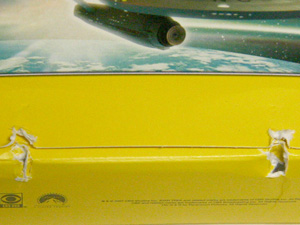
The HD DVD begins with Kirk's voice declaring "transporter room ..." and a brief animation of the turbolift taking us to that destination. The primary menu features a nice rendering of the transporter console, while periodically panning the virtual camera over to the platform where characters from the specific episodes of that disc materialize. The menu itself slides in from the left in a tablet interface that is sometimes awkward to navigate. First, you select the episode (numbered by production order, listed in airdate order), and then you select what action you want to perform on it, such as "Engage" (play) or "Communications" (soundtrack and subtitles). This is fine, except when the episode features the "Starfleet Access" option. In this case, you have to choose the episode, then choose "Starfleet Access", then enable "Starfleet Access", then go back up to the options, and finally select "Engage". This is a lot of extra clicking for a simple procedure. The interface also falls apart on the final disc where there are four bonus features that can only be accessed by selecting one of the two episodes on the disc (that have nothing to do with the bonus material), then "Additional Data", and then scrolling through the list. I also found it irritating that pausing brought up a time scroll that could not be cleared from the screen by any method I could find. There is no "Play All" option, but when one episode is completed, at least the next one is pre-selected. On the whole, it looks pretty good; it's just not that intuitive and is sometimes downright annoying. Standard-definition menus are a simplified version of the same concept.
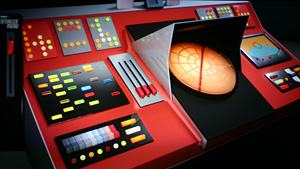
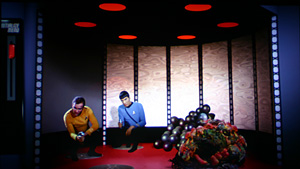
VIDEO:
When I saw my first remastered episode in high-definition, I heard George Takei's voice in my head: "Oh my!" I remember how disappointed I was when I got my first Trek DVDs and found the colors dull and lifeless, the detail lacking, and the print damage incredibly distracting. The improvement on this latest release is, for lack of a better phrase, jaw-dropping. Star Trek is packed with vibrant colors intended to dazzle the early color television owners, and with the restoration done on these episodes, those colors have never looked better. I couldn't take my eyes off of Uhura's bright green earrings. A great deal of print damage has been cleaned up as well, and while I did spot some moments where dirt or other damage was missed in the final presentation as well as slight compression problems across solid blocks of background color, the overall improvement is significant and obvious on even the tiniest of screens. Black levels could be slightly deeper, but on the whole, they're very good, with strong shadow detail. Most of these comments apply to both HD and SD presentations, each in the appropriate 4:3 aspect ratio.
On the HD DVD side (1080p with MPEG4-AVC), detail is simply incredible. In Sickbay, the text descriptions of the various monitor readouts are clearly visible in a way I had never seen before. Zippers on the costumes stand out all over the place, and the Romulan uniforms from "Balance of Terror" have a wonderful texture to them. Because of the way the series was filmed, there is certainly a great deal of variance here, as the masters for some shots are simply out of focus, and of course, there's the annoying Trek style of filming all female close-ups with a ridiculously soft filter. But the detail on the male close-ups is gorgeous, and there are more than enough dramatic improvements on this set to make clear the value of high-definition treatment, even for a 40-year-old television series.
| Original SD | SD Restoration |
|---|---|
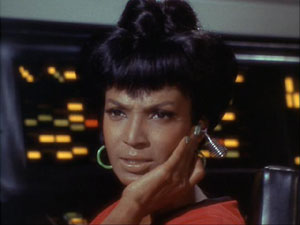 | 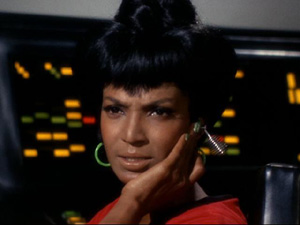 |
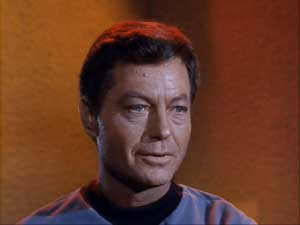 | 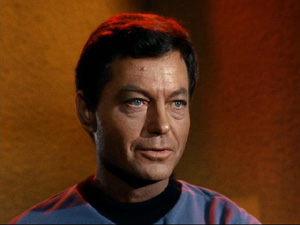 |
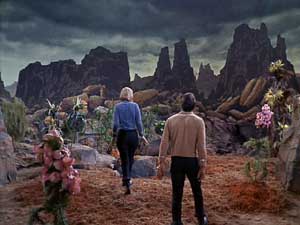 | 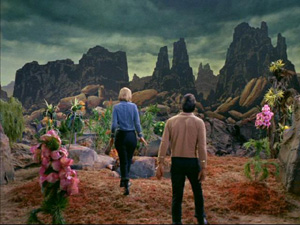 |
| * These images are compressed for web viewing and intended to display color restoration. The high-definition detail on the HD DVD is incredible. | |
| Original SD | SD Enhancements |
|---|---|
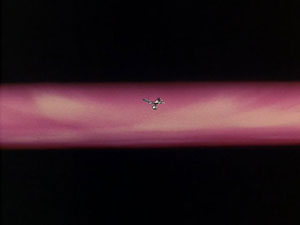 | 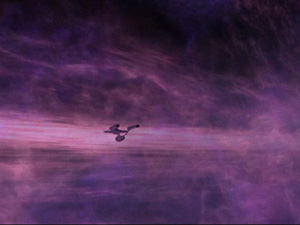 |
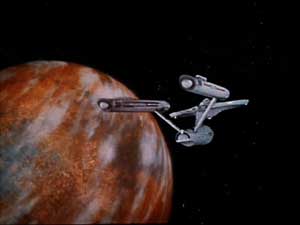 | 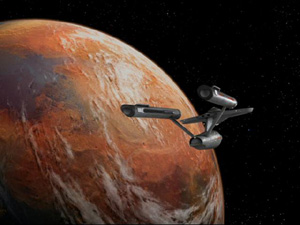 |
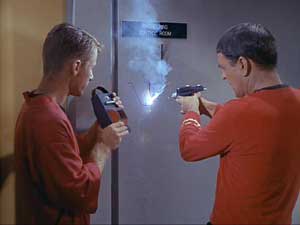 | 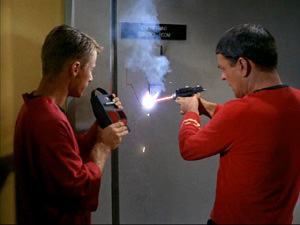 |
 | 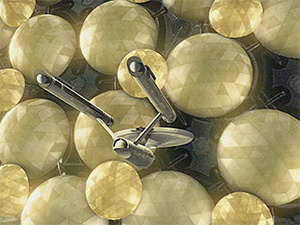 |
| * These images are compressed for web viewing and intended to display effects enhancements. The high-definition detail on the HD DVD is incredible. | |
Planets are gorgeous, and the improvements on matte paintings add much more depth and dimension to the show. Countless subtle changes from a window in Pike's quarters to the shimmering effect when a character disappears really do enhance the overall presentation. More obvious enhancements add scope, like the incredible visual of Balok's Fesarius in "The Corbomite Maneuver" or the Murasaki 312 formation in "The Galileo Seven". Klingon ships are added for the first time where they should have been all along in "Errand of Mercy", and Khan's Botany Bay is digitally reconstructed for more realistic spaceflight. It's unfortunate they didn't have more time and money for this process, because it's clear some episodes received more love than others (and closing credits went completely unloved), but you can't have everything.
All of this material looks great (save some slight digital artifacting in a few places), and I don't want to get fanboy nitpicky, but I have to admit that a few small replacements irked me. One of those areas is the analog chronometers, which have now been replaced by digital. I know analog makes no sense in our current future, but Star Trek is an analog series, and the change just feels wrong. There's also a spot in "The Menagerie" where they've remastered the awkward shot of a shuttlecraft chasing the Enterprise into something much more vivid. However, the consequence of such an enhancement is this new craft requires a name and a registry, which they have now created. Finally, there are some scenes where the digitally rendered Enterprise just looks too much like a video game model. It's not all the time, and they've added grain into the shots to keep from standing out from the rest of the show, but there are sequences where the depth and texturing aren't quite right and lack the quality you get from a good model. On the whole, I would say that a good 95% of the enhancements are positive, merge nicely into the episodes, and serve the story in a way that makes them more enjoyable to watch, so while a few changes annoyed me a bit, I want to be clear that the overall result is a pretty strong success.
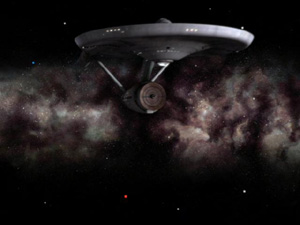
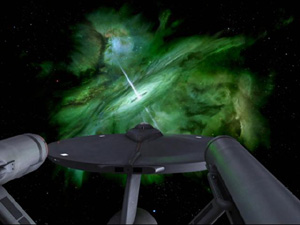
AUDIO:
Audio is available in Dolby TrueHD, and it is superb. While much of the action takes place in the front channels for obvious reasons, this enhanced mix uses the surround stage with great effectiveness in numerous places, from the alert sirens throughout the ship to the atmospheric winds of Talos IV to the ricochet of a stun phase off Professor Crater's chest. The remastered main titles are absolutely fantastic, enveloping the viewer with the title score while the Enterprise whooshes across the speakers. A Dolby Digital 2.0 track is also offered, and when you switch over to it, the difference between the old and the new is staggering. Finally, a Spanish mono track is available, and it's worth checking out just to hear how hilariously bad it is.
Subtitles exist in Spanish and English.
WHISTLES & BELLS:
- Starfleet Access (HD Only)
Available on 7 of the more important episodes ("Where No Man Has Gone Before", "The Menagerie, Parts I & II", "Balance of Terror", "The Galileo Seven", "Space Seed", and "Errand of Mercy"), "Starfleet Access" provides a split-screen way to get more information about the episode in question. Because each episode is presented in 4:3, there are pillars of black on each side of the image. When "Starfleet Access" is enabled, icons stack inside the right-hand column to indicate that more information is available about a planet or ship or life form being focused on during this section of the episode. By clicking on one of the icons, you can send the running episode to the left side of the screen while extra information about that item appears in static form in a window on the right. While every once in a while there was something interesting to be found here, I mostly found it to be gimmicky and not worth my time. The major exception to this, however, is the icon labeled "Genesis", which loads up a parallel video clip on the right with any number of people discussing either the episode as it was produced or the remastering process. Almost every episode features insight from remastering gurus David Rossi, Michael Okuda, and Denise Okuda, story editor D.C. Fontana, Trek expert Bjo Trimble, and writers Judith and Garfield Reeves-Stevens. Then on top of that, Gary Lockwood and Sally Kellerman are available for "Where No Man Has Gone Before", Harve Bennett talks about "Space Seed", and Bob Justman is scattered throughout as well. Frankly, I could listen to Michael Okuda talk about Trek for hours on end, and most everyone else is very engaging too (except one popular fan who offers nothing of substance on "Space Seed"), and these video clips serve as a great companion to the episodes.
One note here that I could not find mentioned in the documentation: if you select "Genesis" the first time it appears on screen and don't select anything else after that, each subsequent "Genesis" clip will begin playing without requiring additional input. This is incredibly helpful, because the icon shows up a few seconds before the clip is supposed to start, and there's no feedback that it will begin shortly, so having to manually start each one over the course of 51 minutes can get very frustrating. Selecting it just once and letting it play on its own, however, is a much better experience. Come back later and click on the other icons if you wish.
- Interactive Enterprise Inspection (HD Only)
This is an "interactive" experience where you board the Shuttlecraft Jeffries and take an observational position outside the Enterprise. By selecting different sections of the ship from a list, you can direct the shuttlecraft to that section and listen to audio that describe the purpose and functionality. Some parts of the ship can be linked together where you can travel from one point to the next, but other times you have to navigate back to the starting coordinates and begin again. This is one of those features that may have looked good on paper, but just wastes space on the disc.
- Spacelift: Transporting Trek Into the 21st Century (HD/SD 20:05)
Everything about the new remastering project is covered here from the mastering process itself to the coloring to the recording of new music. Senior Vice President of CBS/Paramount David LaFountaine contributes thoughts as well as David Rossi, Michael Okuda, Denise Okuda, and numerous other individuals involved in the project.
- Billy Blackburn's Treasure Chest: Rare Home Movies and Special Memories (HD/SD 13:20)
Recognized by many as the seemingly nameless helmsman who would stand up and walk away to clear the scene for the actors with lines, Blackburn found his way into almost every episode of the original series, mostly as the character Lieutenant Hadley, but sometimes as the white rabbit in "Shore Leave" or the close-up version of the Gorn captain in "Arena". Here he talks about his experiences on the show as a lesser-known individual and shares some of his personal home movies. It's short but entertaining.
- Birth of a Timeless Legacy (SD 24:13)
Mostly interview footage of key players (William Shatner, Leonard Nimoy, Robert Justman, Gene Roddenberry, etc.) talking about the genesis of the series. For the die-hard fan, there isn't a great deal of new material here, but it's organized fairly well.
- Reflections on Spock (SD 12:12)
Leonard Nimoy talks about his experience with the character and the controversy that surrounded his book, "I am Not Spock".
- Life Beyond Trek: William Shatner (SD 10:41)
Less interesting (and topical) than Nimoy's piece, Shatner discusses his love for horses and demonstrates movements he uses in riding competitions.
- To Boldly Go ... Season One (SD 18:58)
This is a pretty solid retrospective regarding the first season as a whole. Many familiar faces from the other bonus material contribute as well as memorable guest stars like Ricardo Montalbán and William Campbell.
- Sci-Fi Visionaries (SD 16:37)
Robert Justman and Dorothy Fontana talk about the effort to hire known science fiction writers to work on the early episodes and give them some literary depth. Theodore Sturgeon, George Clayton Johnson, John D.F. Black, and Harlan Ellison are covered here. Sadly, Harlan does not appear himself.
- Kiss 'n' Tell: Romance in the 23rd Century (SD 8:33)
A brief series of clips and interview footage discussing some of the various love interests in the series and films. It's not particularly interesting.
- Trekker Connections (SD 3:56)
A series of "Six Degrees" relationships between various actors on the show presented in a game format. I have no idea why anyone wasted time creating this.
- Star Trek: Beyond the Final Frontier (SD 1:29:56)
Hosted by Leonard Nimoy, this is a wonderful documentary on the series and its fandom that the History Channel aired in conjunction with the 40th Anniversary auction at Christie's. I really enjoyed watching this again.
- Star Trek Online Game Preview (SD 3:27)
A brief preview of the upcoming online game. Most of the material is still in conceptual art stages, so there isn't much to see here.
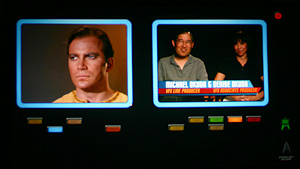
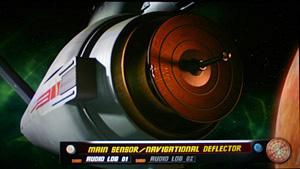
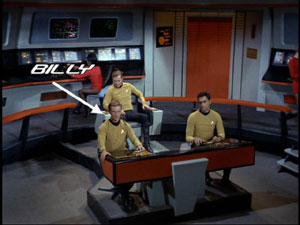
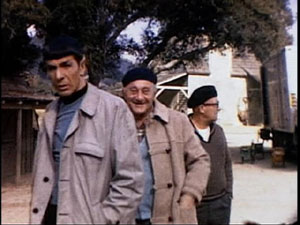
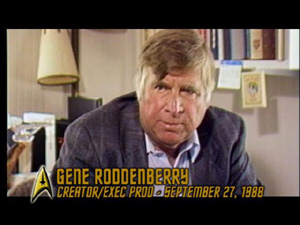
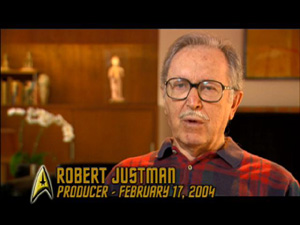
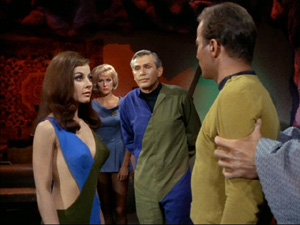
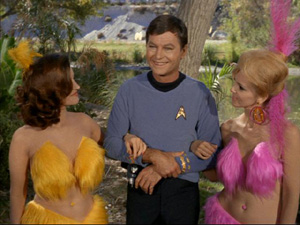
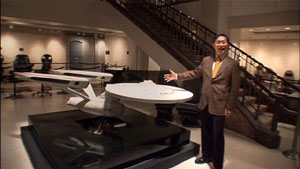
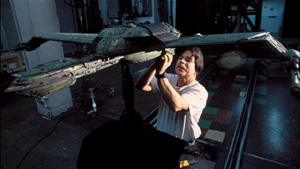
High-definition bonus features are on Disc #10, while standard-definition material is spread across all the discs. "Star Trek Next Voyage" previews are only available on the standard-definition sides of the discs. Obnoxiously, there is a preview for Twin Peaks on the first SD disc.
CONCLUDING THOUGHTS:
Star Trek is my first love. I watched many other series prior, and some were appointment viewing, but Star Trek is the first one that ever spoke to me in any meaningful capacity, the first time I genuinely cared about a television show. I've owned these episodes in so many incarnations, seen them in so many venues, that I wonder when it will ever get old. Over 40 years strong and the answer remains ... "not yet". Am I blinded by nostalgia? Possibly. Probably. But there's a quality to these episodes that never stops entertaining me, a sense of wonder about the universe, a hope for the future that never wavers, and a belief in mankind that gives us more credit than we likely deserve. Much of the social commentary remains relevant still today, and the dynamic between Kirk, Spock, and McCoy is pure gold. To say the remastered versions of these episodes are incredible is an understatement, and it is thrilling to see them presented with such vibrance and clarity. Not every episode in this season represents the best of the show, and I do have a few minor complaints with the menu structure and mastering choices; but this is close to a must-own for any fan of this franchise, and on content alone, we're looking at a "Highly Recommended" title knocking on the door of "Collector Series". Unfortunately, the packaging is such a damage-prone disaster that I must regrettably list this as simply "Recommended" with the strong suggestion that you inspect the packaging in person before purchasing this expensive title. One bad sample could be an anomaly, but as Scotty (James Doohan) would point out, "Fool me twice, shame on me."
N.B.: Images in this review exist to look pretty and are in no way representative of the quality of the high-definition transfer.
|
| Popular Reviews |
| Sponsored Links |
|
|
| Sponsored Links |
|
|
| Release List | Reviews | Shop | Newsletter | Forum | DVD Giveaways | Blu-Ray | Advertise |
|
Copyright 2024 DVDTalk.com All Rights Reserved. Legal Info, Privacy Policy, Terms of Use,
Manage Preferences,
Your Privacy Choices | |||||||















